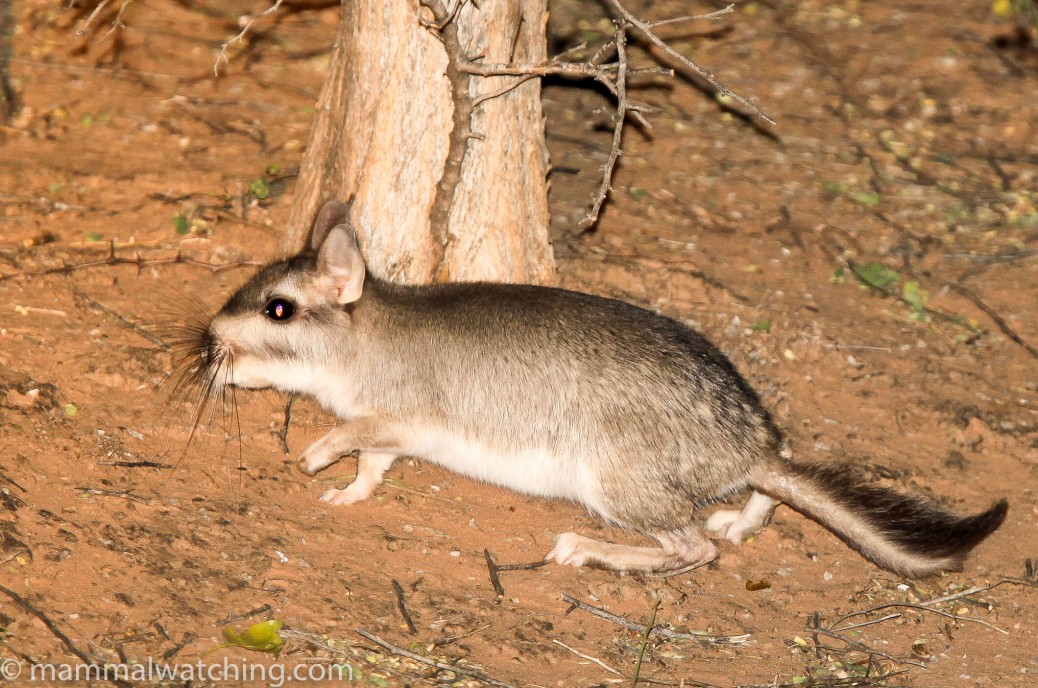
Paraguay
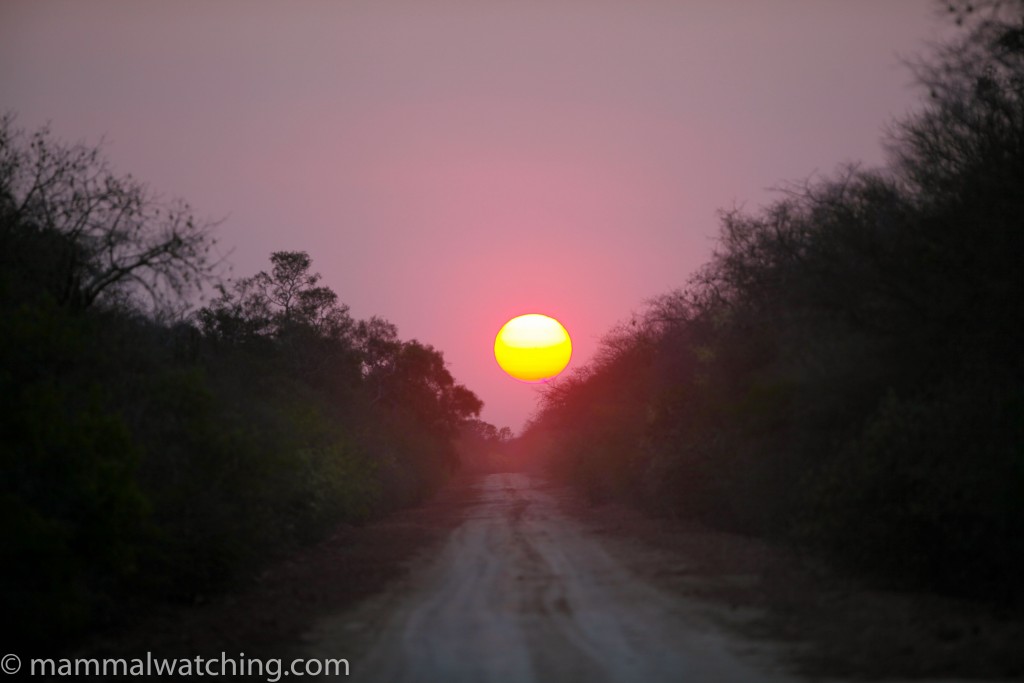
Sunset, Defensores del Chaco National Park
El infierno verde, the green hell, as the Chaco is known, straddles Paraguay and Bolivia. It is one of the most inhospitable places on the planet: hot, dry and dusty and the dense thorny forest is all but impenetrable save for the handful of dirt tracks that have been bulldozed through. It is also home to some interesting mammals, best of which is the fabulous Chacoan Peccary, the largest of the three peccaries and unknown to science until 1975 when the first live animals were found (remains had been discovered in the 1930s and were thought to be from an extinct pig).
Ever since hearing about Fauna Paraguay’s mammal tour of the Chaco, and reading Sjef Ollers’ excellent trip report, I was keen to visit. In August 2010 I got there.
I arranged the trip through Fauna Paraguay. I was the first customer for their mammal tour, which involved looking for the larger animals but also trapping for small mammals and mist netting for bats. Fauna Paraguay’s website is already a fabulous resource for the country’s wildlife and Paul Smith, one of the partners, is in the process of writing a complete guide to all of Paraguay’s mammals (with the PDFs becoming available on the site). I only had a week so decided to spend my time only in the Chaco. I was originally tempted to try to spend a few days in the Atlantic Forest too but it wasn’t possible in the limited time I had available.
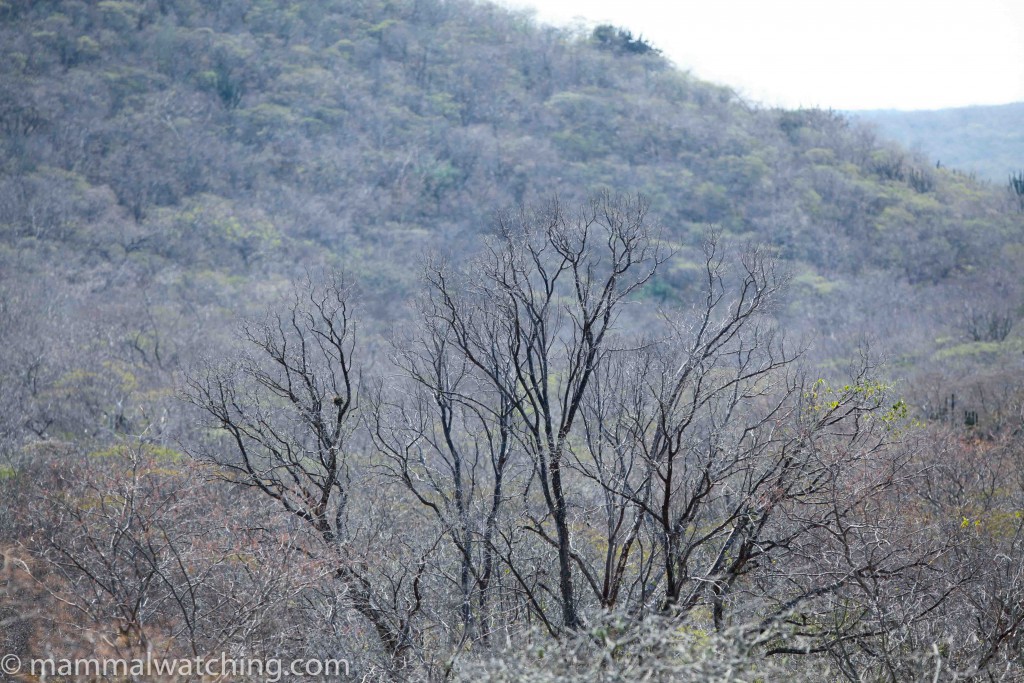
Cerro Leon, Defensores National Park
August is the depths of the Paraguayan winter. The temperatures can vary considerably. The week before I arrived it had got down to below freezing one night and several thousand cattle had dropped dead, apparently from hypothermia. The weather had warmed up a bit by the time I arrived but got steadily colder during my stay and we had frost on the last night. Although the temperature reached about 35C on a couple of days it was often a bit too cold at night for many bats to be flying. Perhaps the weather also explained the disappointing lack of armadillos other than the Three-banded Armadillos.
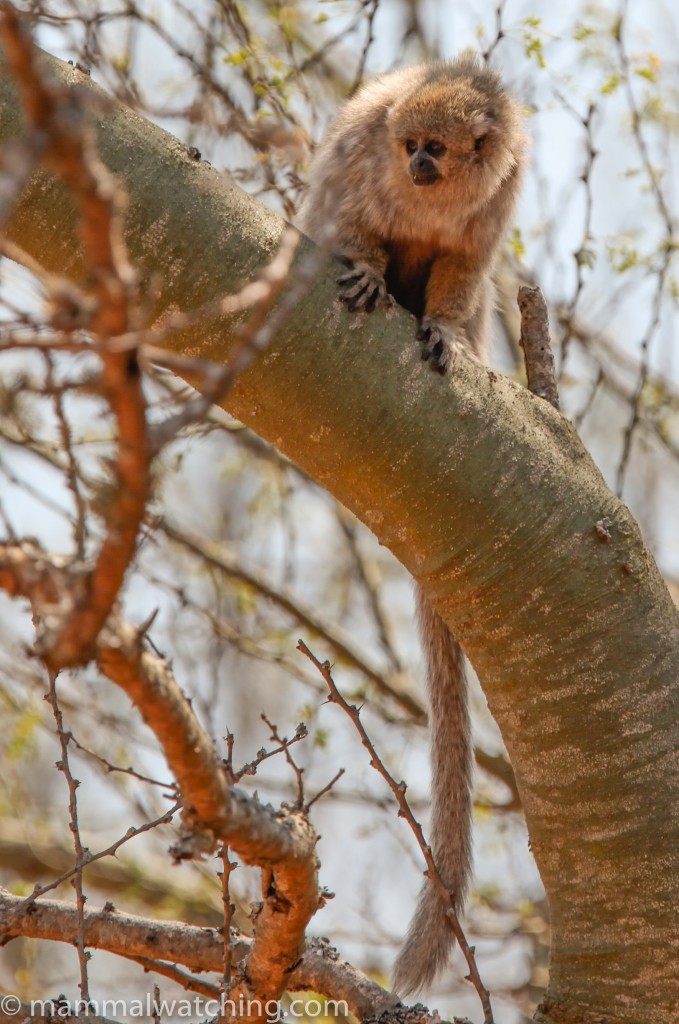
Pallid Titi, Callicebus pallescens
The tour was organised by Hugo Del Castillo Cordero, another of the Fauna Paraguay partners. Though primarily a birder he knew a lot about the mammals and where to see them. He also drove, cooked and arranged as much beer as I could drink. We were accompanied by Robert Owen, a US mammalogist who has settled in Paraguay. Robert was in charge of all the trapping and netting and (thankfully) identifying the things we caught.
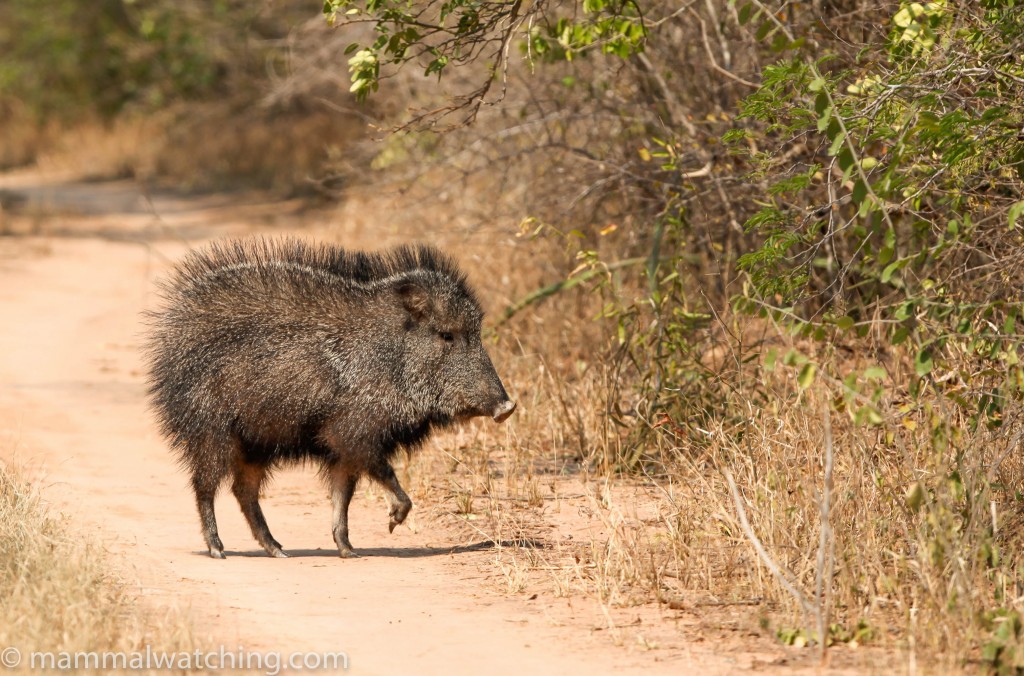
Chacoan Peccary, Catagonus wagneri
Robert and Hugo met me at Asuncion airport on Saturday morning, with a loaded Ute. We crossed the Rio Paraguay and started the long drive north through the Chaco.
Very few people live in the Chaco. There are increasing numbers of cattle stations, and a few small Indian communities, but much of the area is wilderness. A patchwork of “self protected” national parks are scattered across the forest. “Self-protected” means no resources are spent on them, but as the forest is so difficult to enter there are few problems with people other than hunting along the roads that border the park. Mammal watching revolved mainly around driving along the same roads and hoping that an animal would cross in front of us. This was quite effective.
Loma Plata
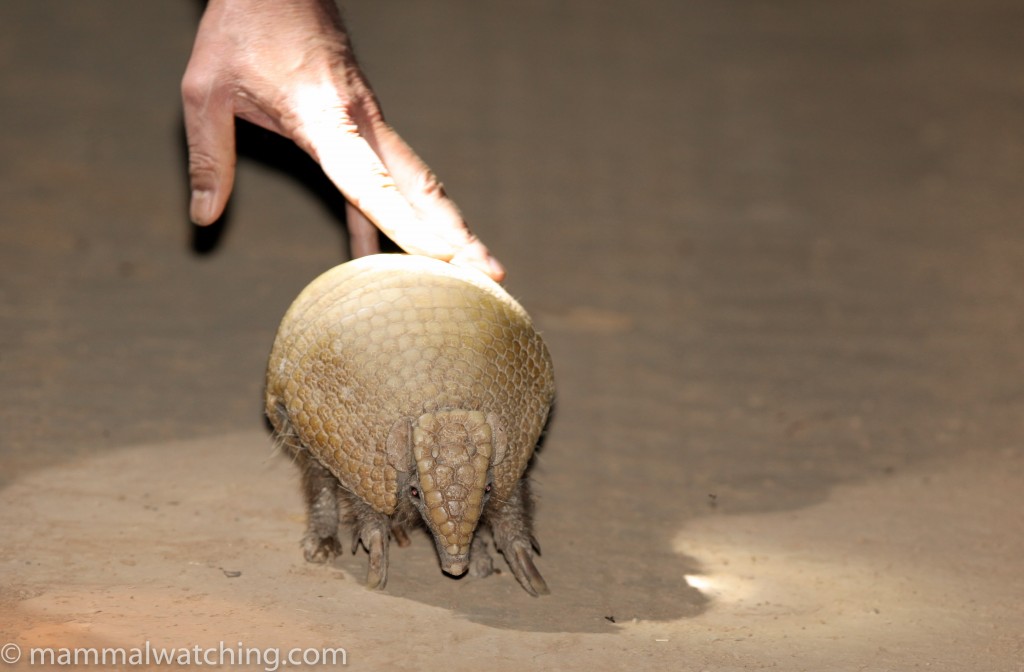
Southern Three-banded Armadillo, Tolypeutes matacus
We spent the first night in the little Mennonite community of Loma Plata, 450 km north of Asuncion. It is a prosperous town that could have been Australian at first glance (other than that the posters were in Spanish and German).
As soon as we had checked in to the hotel, Hugo offered to take me for an evening/night drive to a patch of protected bushland managed from the Tunokojai Indian reservation. A Lowland Yellow-toothed Cavy shot across the road just after dark and we later we saw three separate Three-banded Armadillos, the first of which Hugo caught. They are brilliant little critters, running on their tip-toes like obese ballerinas.
Defensores del Chaco National Park
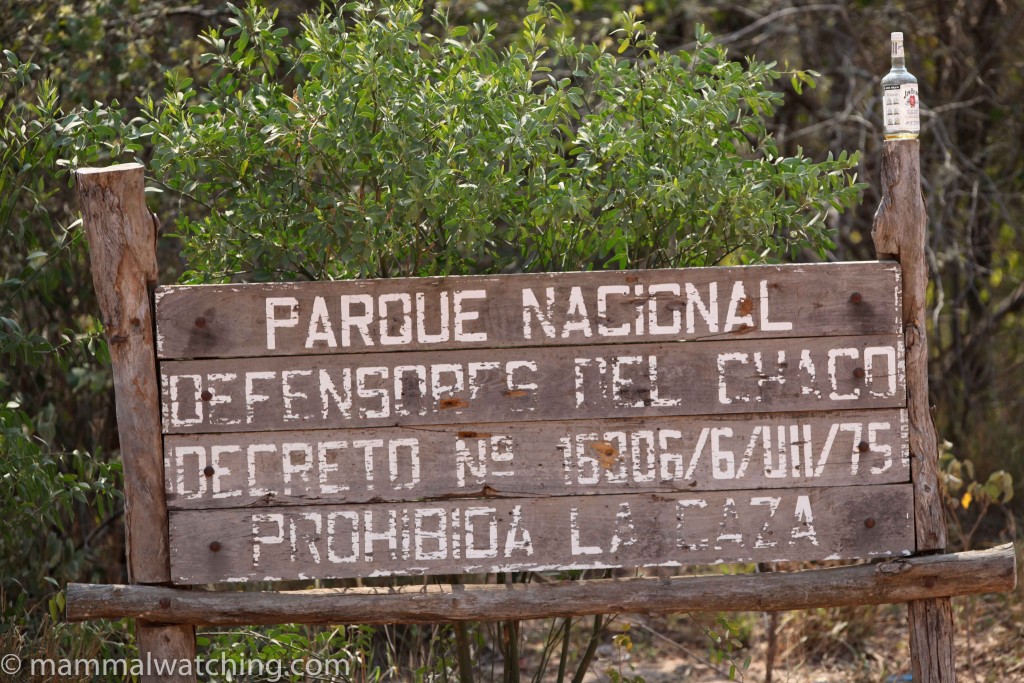
The next morning we left for the six hour drive north to Defensores del Chaco National Park, where we would spend the next three nights. It is dirt road all the way, but the road was in surprisingly good condition so we drove the 240 km in 5 hours, not the eight that Hugo had expected. The only mammal was a very large, brick-coloured Tapir near a farm dam. It was a surprise for me to see these animals living in such dry habitat, but they are quite common in the Chaco. Hugo has often see Chacoan Peccaries along the road but it now sees a lot more traffic than it used to, and the wildlife sightings have likely deteriorated as a result.
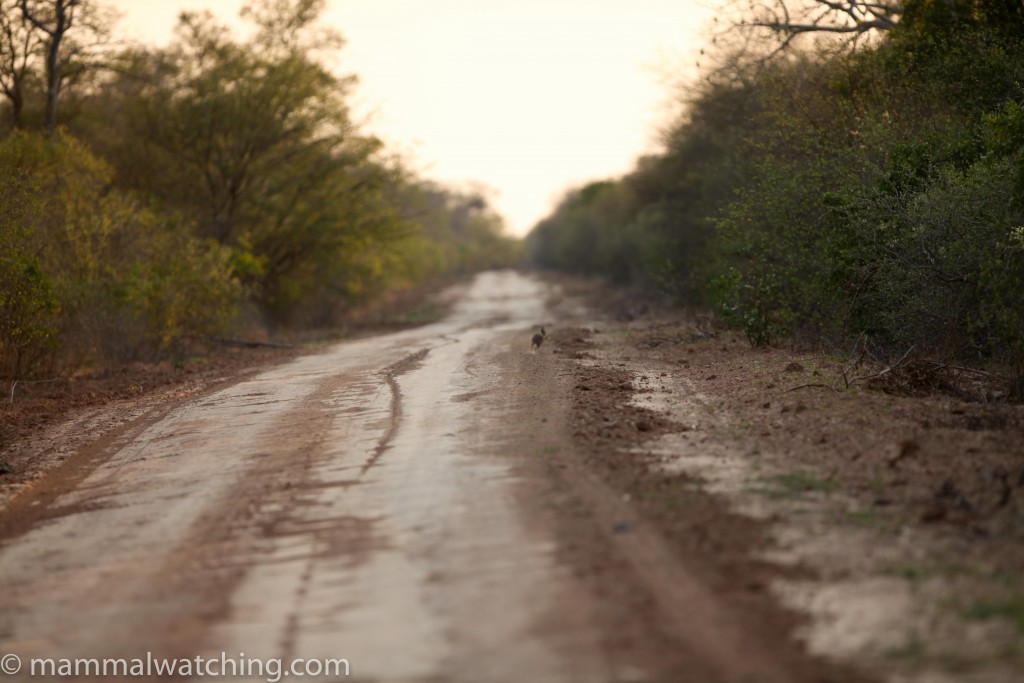
Another busy Chaco road
We stayed at Madrejon in the south-east corner of the park at what might best be described as a ranger station (though in fact the people working there are not really rangers … the park is ‘self protected’). We spent our time setting traps and nets and looking for wildlife along the road. It is a gloriously remote area, very reminiscent of outback Australia.
Chacoan Peccary, Catagonus wagneri
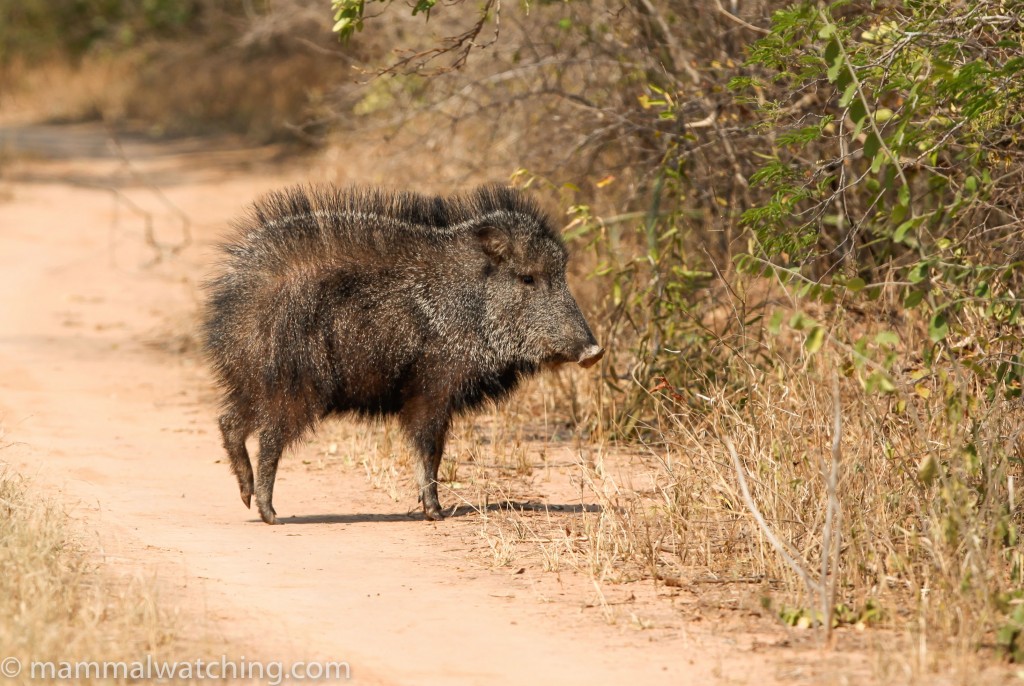
Chacoan Peccary, Catagonus wagneri
Defensores is the place to look for Chaco Peccary. But they were not as easy to find as I had imagined. Indeed, looking for mammals in the Chaco – by driving the roads hoping something will cross – was like needles in haystacks, but it works. We eventually had great views of a lone male on the road to the Cerro Leon campsite. They are a strange looking pig: imagine a Collared Peccary that has taken some powerful growth hormone which inflated everything but its legs.
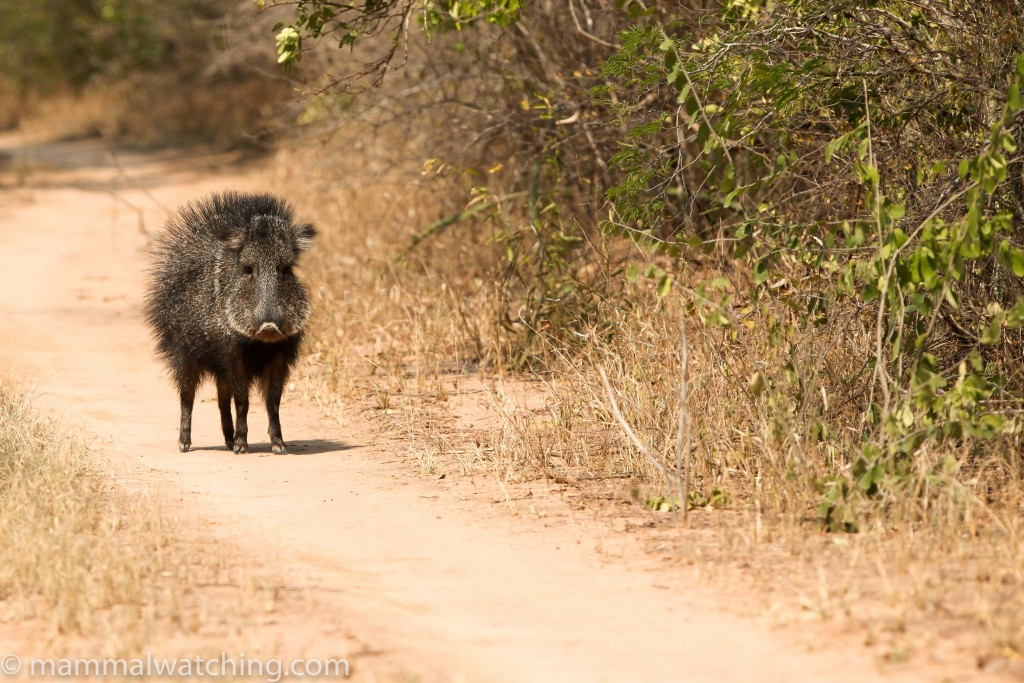
Chacoan Peccary, Catagonus wagneri
We had saw another animal cross the road on the long drive between Defensores and Enciso, and shortly after had distant views of a sounder of six crossing the road.
Chaco Mara, Dolichotis salinicola
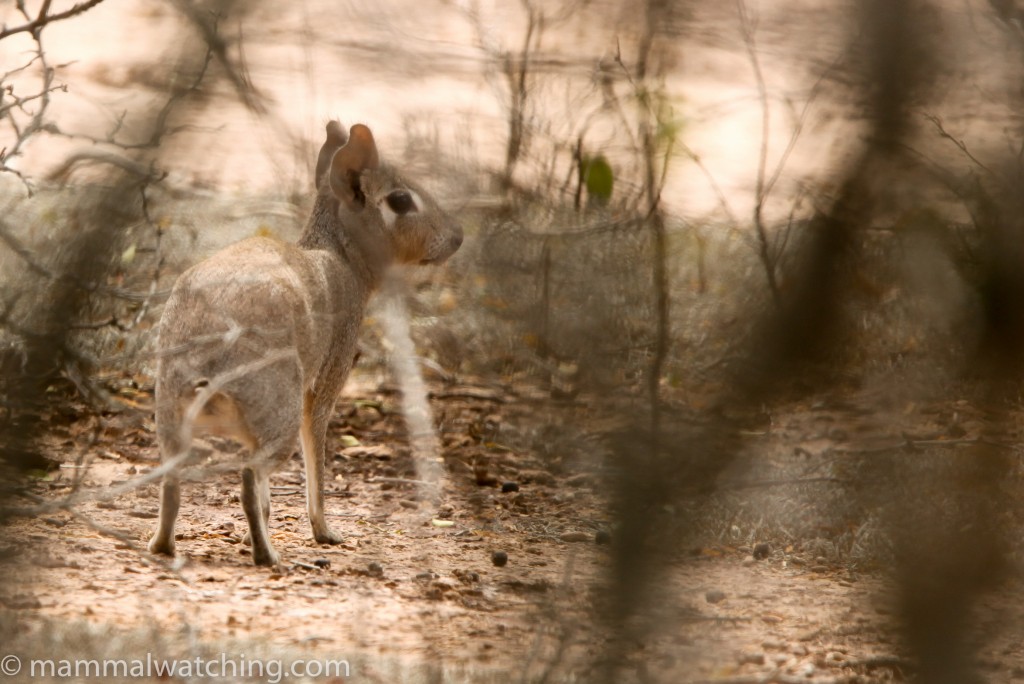
Chaco Mara, Dolichotis salinicola
Chaco Mara were another species high on my wish list and also a strange looking beast. They seemed most active in the late afternoon but again it was rather hit or miss. On our first day in Defensores we saw about 10 pairs along the road to Cerro Leon, mostly near Madrejon, between 4 p.m and 5.30 p.m. But during our cooler days we saw only a couple. There were at least one pair living within a few hundred metres of the accommodation at Madrejon.
Pale Titi Monkeys, Callicebus pallescens
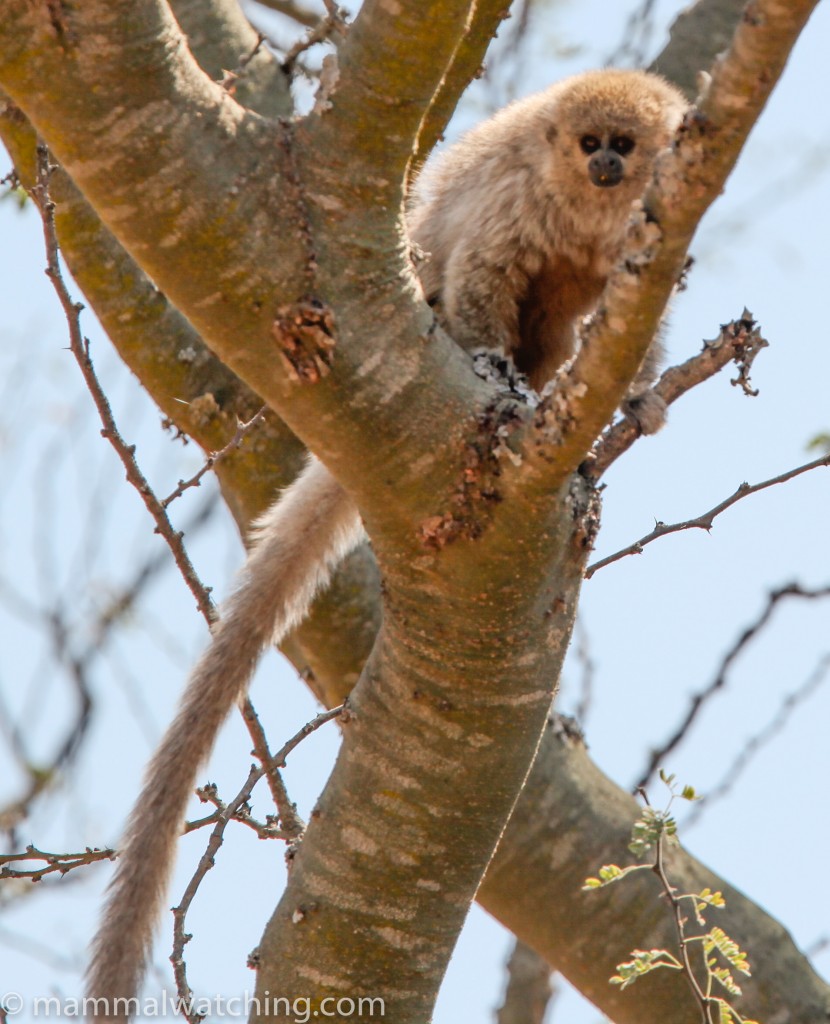
Pale Titi Monkeys, Callicebus pallescens
Pale Titi Monkeys (Callicebus pallescens) are scattered across the Chaco. Hugo is very good at spotting them and on our last day we saw two groups well along the road to Cerro Leon: try looking in the taller trees by each of the two bridges some 5 – 7 km before the Cerro Leon turnoff. They are a nice looking monkey. We also saw a group of four at 8 a.m. at Agua Dulce (see below) and heard several groups calling very loudly.
Azara’s Night Monkey, Aotus azarai
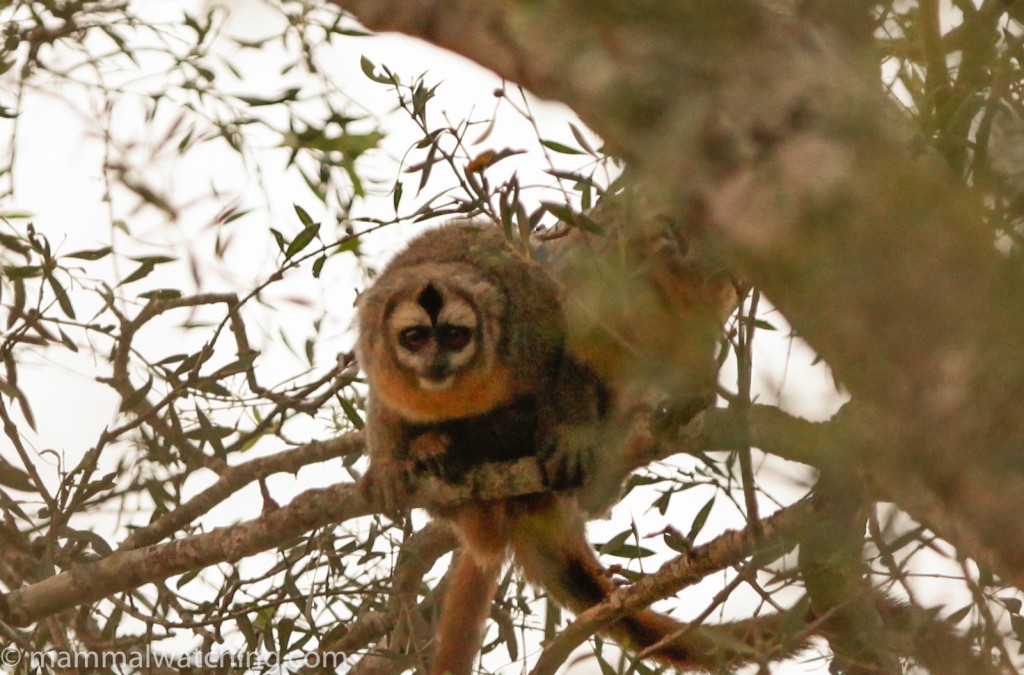
Azara’s Night Monkey, Aotus azarai
The azarae subspecies of this night monkey (perhaps destined for a split) are also distributed across the Chaco. Amazingly Hugo spotted some on the first evening in the same tree he had seen them a year earlier, about 35 km along the road to Cerro Leon. We saw them at sunset though the IUCN site says this subspecies are active day or night in the Chaco.
Black-tailed Marmoset, Callithrix melanura
The closest site that Hugo knows for these marmosets is Agua Dulce, about 80 km or 2 bumpy hours, north of Madrejon. We arrived at dawn on a cold morning but didn’t spot any primates until about 9 a.m. and got good views of just a single marmoset. This is the same species found in the Pantanal, but is again perhaps a candidate for a split.
Southern Three-banded Armadillo, Tolypeutes matacus
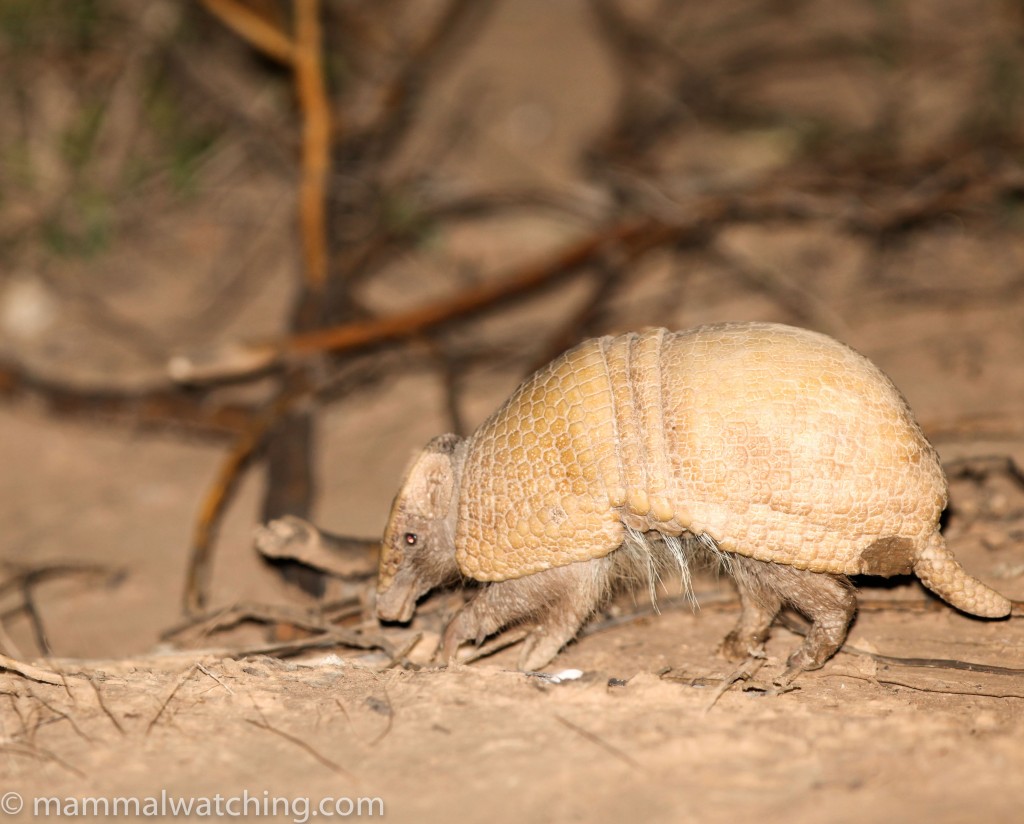
Southern Three-banded Armadillo, Tolypeutes matacus
We had several sightings of Three-banded Armadillos along the road to Cerro Leon in the mid afternoon one day.
Puma, Felis concolor
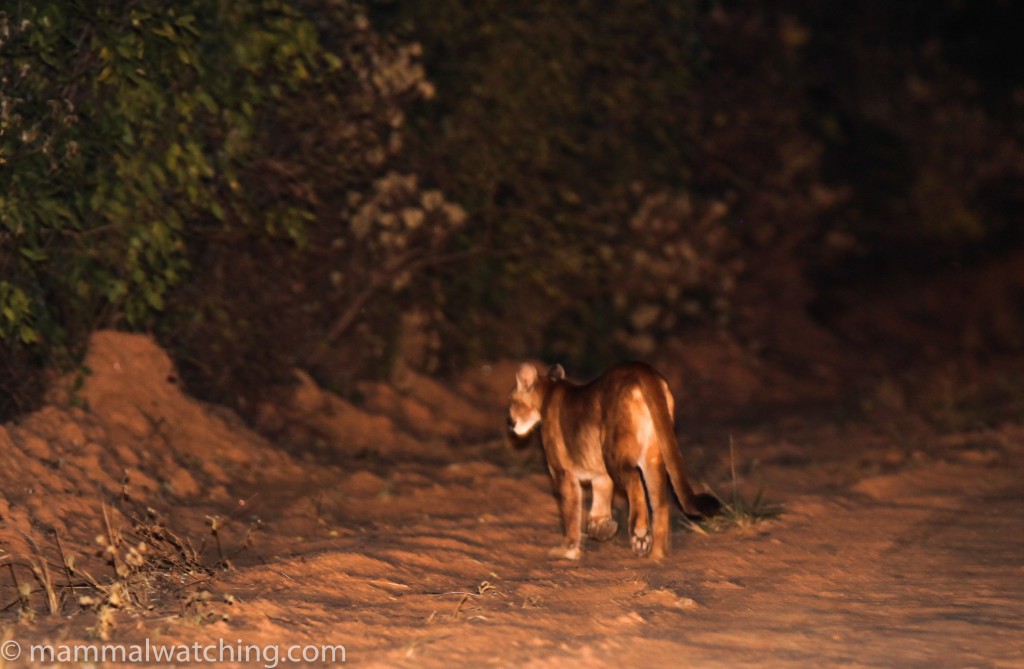
Puma, Felis concolor
We saw a young Puma seen very well just after dark walking along the road about 20km from Madrejon. What was also probably a Puma – but may have been a Jaguar – crossed the road while we had stopped at Agua Dulce at around 8 a.m. I made no real effort to see this species (we did not spend a great deal of time spotlighting in Defensores) and judging by quantity of tracks and droppings we found they seem particularly easy to see in the Chaco, perhaps because they tend to use the road and haven’t got many roads to choose from.
Crab-eating Fox, Cerdocyon thous
We saw one crossing the road after dark near Madrejon.
Gray Brocket, Mazama gouazoupira
One or two seen every day.
Azara’s Agouti, Dasyprocta azarae
We probably heard one early in the morning near Agua Dulce.
Bats
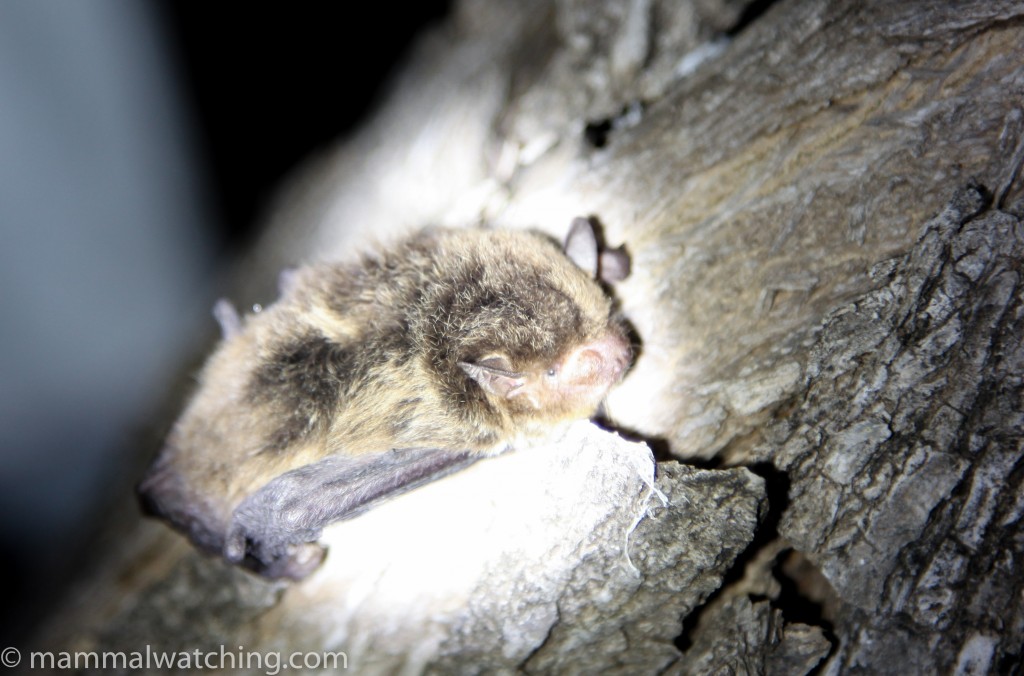
Argentine Brown Bat, Eptesicus furinalis
Mist betting for bats at Madrejon was disappointing, and numbers of captures seemed inversely correlated with the numbers of nets (though I suspect more related to the declining temperatures each night). On the first night Robert quickly caught four little Dwarf Dog-faced Bats (Molossops temminckii) in one net. The second night, with three nets open, brought one more Molossops temminckii and a couple of Argentine Brown Bats (Eptesicus furinalis). Despite having all 5 nets open on the last night we caught nothing.
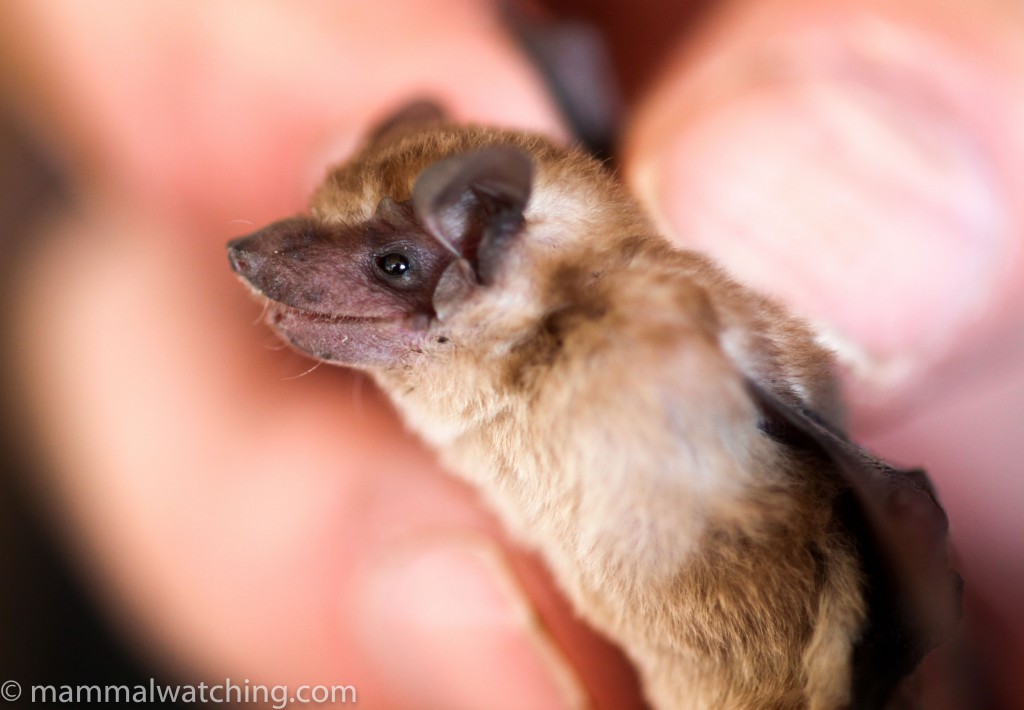
Dwarf Dog-faced Bat, Molossops temminckii
Small Mammal Trapping
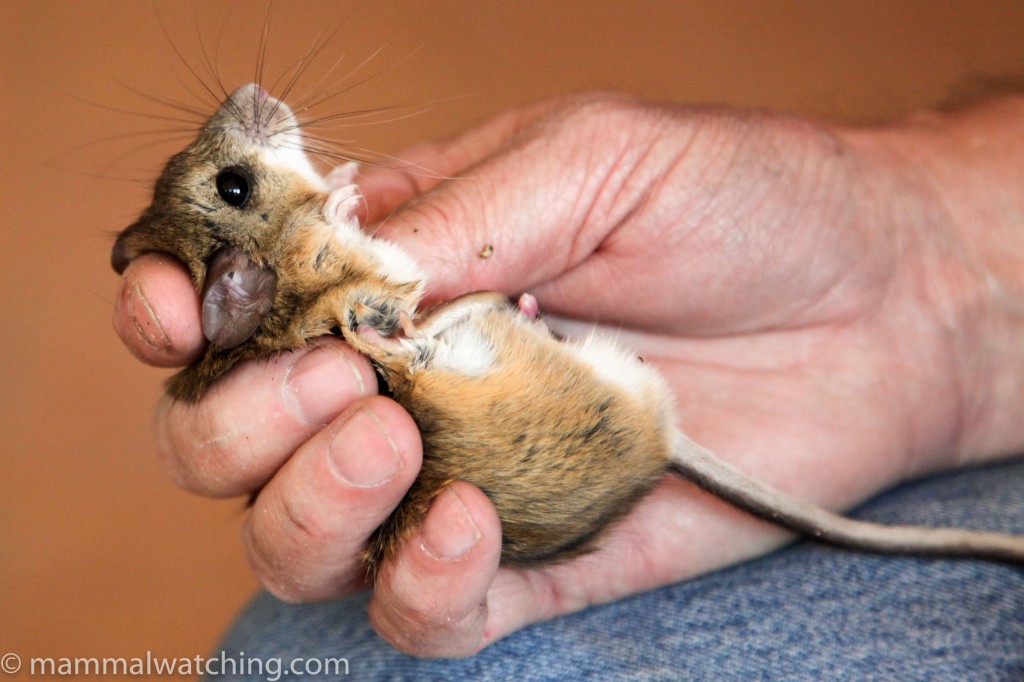
Chaco Leaf-eared Mouse, Graomys chacoensis
Trapping was patchy as you might expect in such dry habitat. We set 100 sherman traps at Madrejon for two nights and then in the rockier habitat, and around the dam at Cerro Leon, for a night.
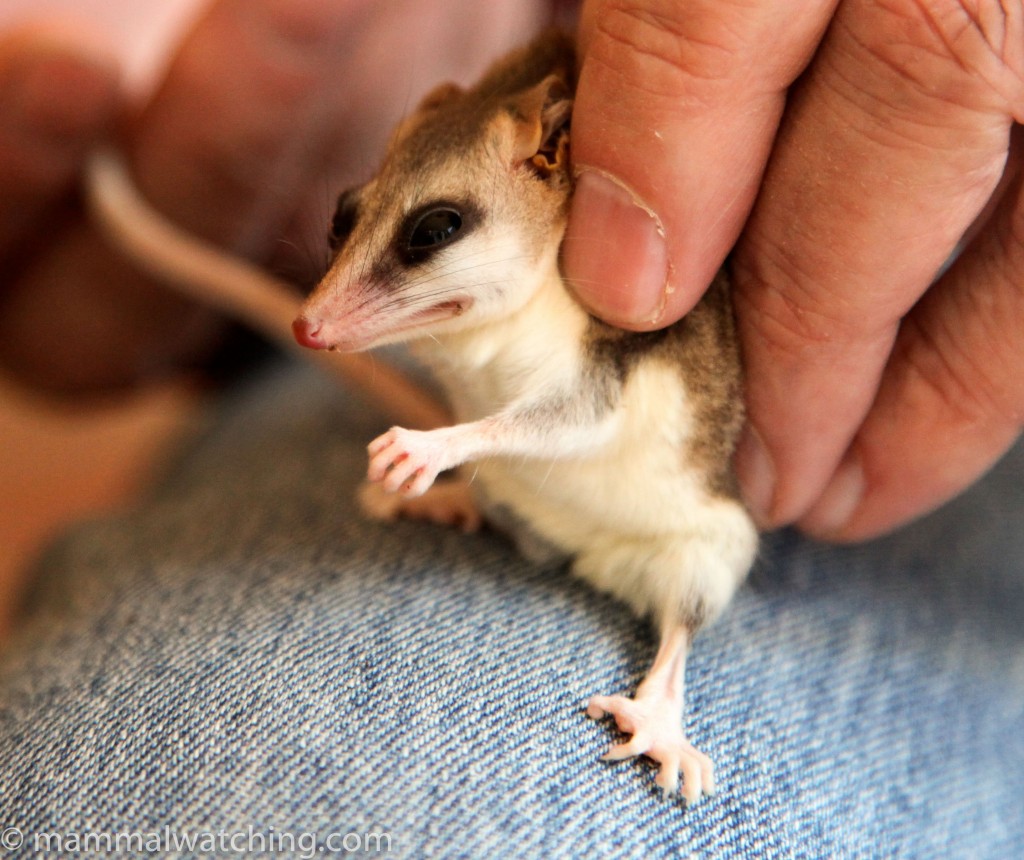
Agile Mouse Opossum, Gracilinanus agilis
At Madrejon we caught two groovy Agile Mouse Oposums (Gracilinanus agilis), one Small and one Large Vesper Mouse (Callomys laucha and Callomys callosus respectively) and several of the quite chunky Chaco Leaf-eared Mice (Graomys chacoensis).
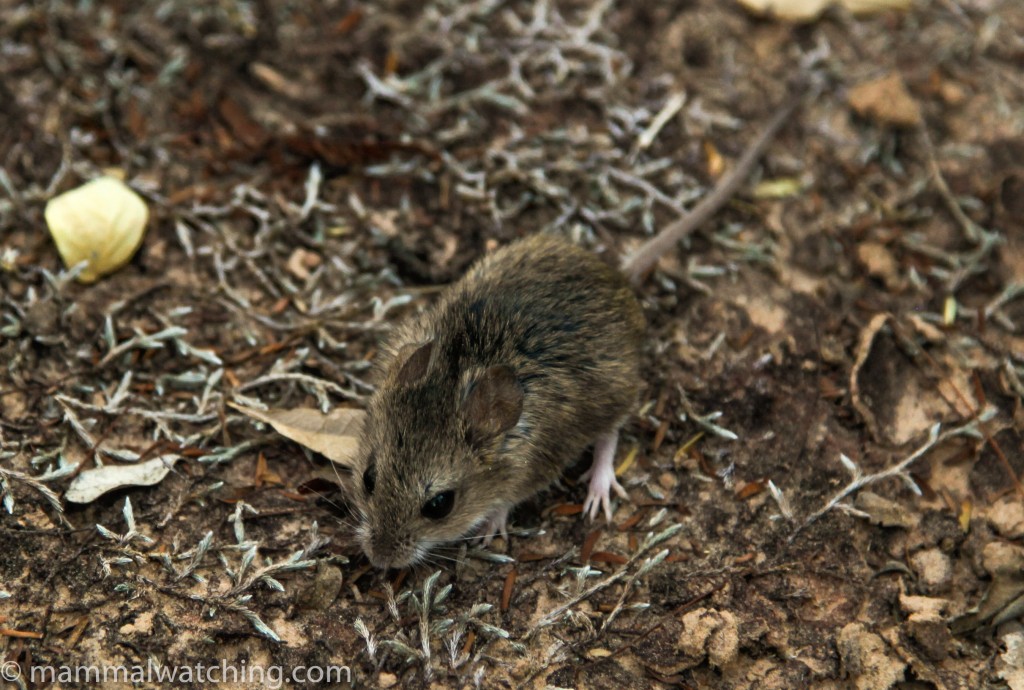
Small Vesper Mouse, Callomys laucha
I would have wasted hours and hours trying to identify these so it was great to have Robert around to quickly ID each animal. At Cerro Leon we caught nothing in the rocky forest, but the swampy grassland around the dam was fully of Callomys callous, with one in nearly every trap through the swamp.
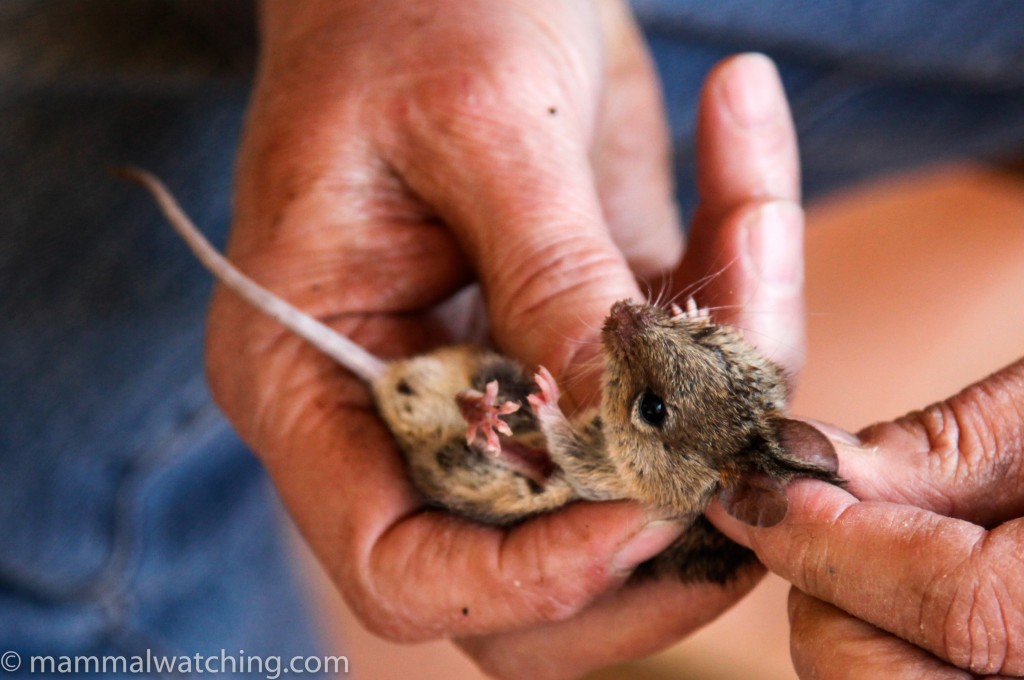
Large Vesper Mouse, Callomys callosus
Enciso National Park
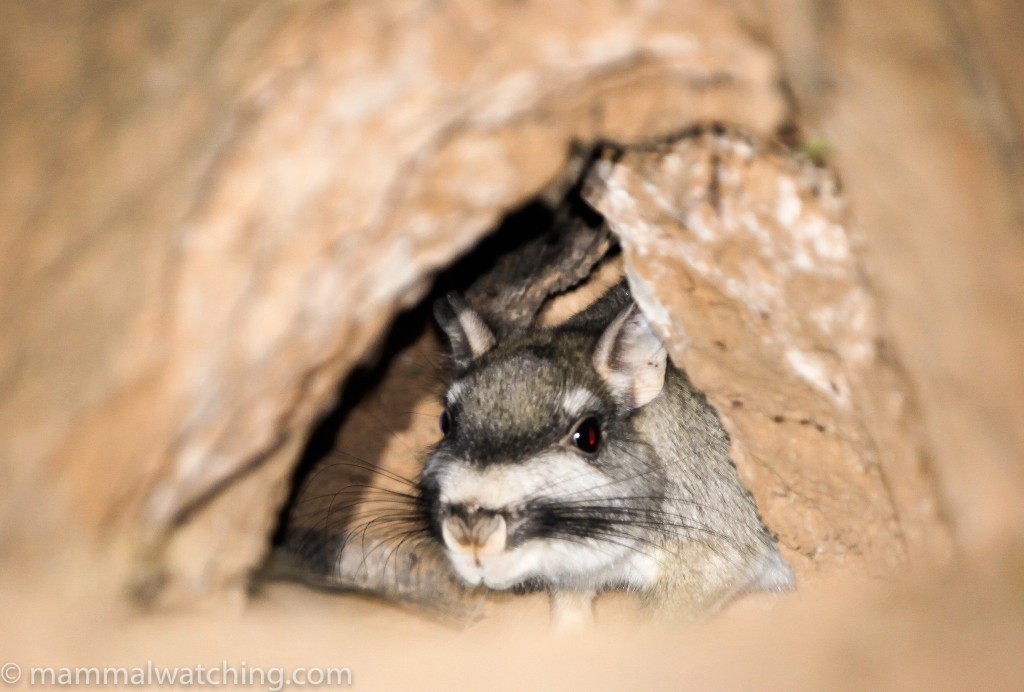
Plains Viscacha, Lagostomus maximus
This national park is about 220 kms west of Defensores, but the drive there is more like 300 kms because there is not a direct road. The accommodation is similar to Defensores, though there is also permanent electricity here. The forest is a little more open in places and the soil sandier so there were some different mammals around including Plains Viscacha. We spent three nights here, again trapping and mist netting each night, and looking for stuff during the day and night.
Plains Viscachas, Lagostomus maximus
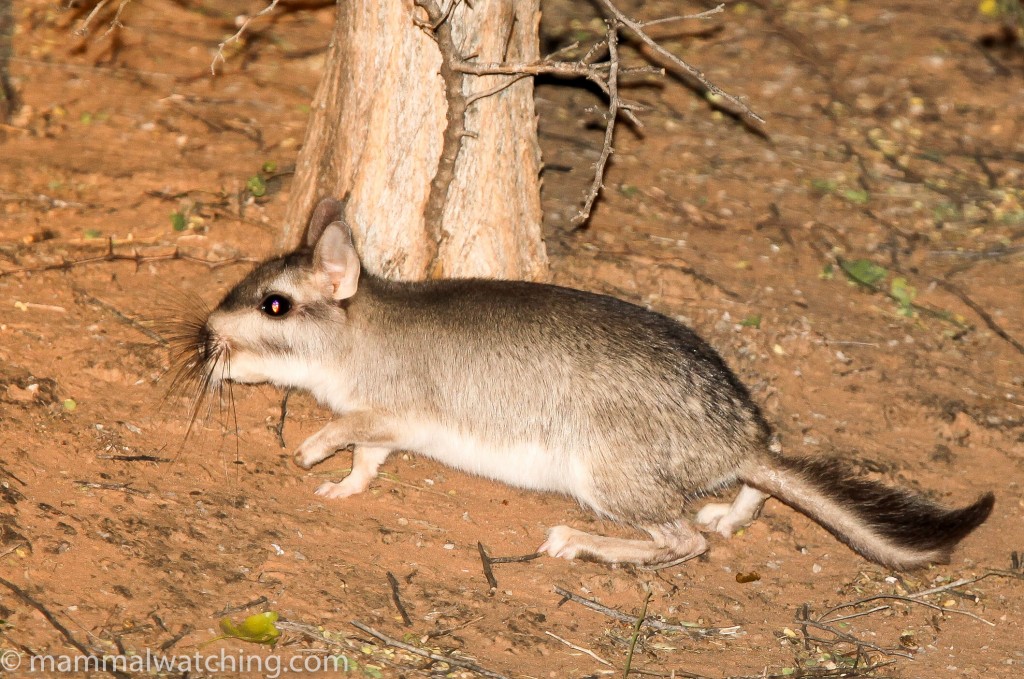
Plains Viscacha, Lagostomus maximus
Plains Viscachas appeared to be very common to the north of Enciso. There were many burrows along the road, and they were impressively large and easy to spot because they are cleared of vegetation. But the viscachas were less easy to spot. We looked but couldn’t find any on our first two nights, maybe because there was a cold southerly wind (I have no evidence to support this theory whatsoever). On our last night, when the wind had stopped, we staked out an active burrow at dusk and got great views of one animal above and in its hole. Later that night we saw another nine animals including one group of seven. So if you don’t see one at first don’t despair: they are well worth the effort.
Pampas Fox, Pseudalopex gymnocercus
Our only (surprisingly) Pampas Fox was around the accommodation here for two nights running.
Tapir, Tapirus terrestris
Tapir are common throughout the Chaco but I was not looking for them. Rob saw one very close to the accommodation at Enciso, and their tracks and scats were everywhere.
Armadillos
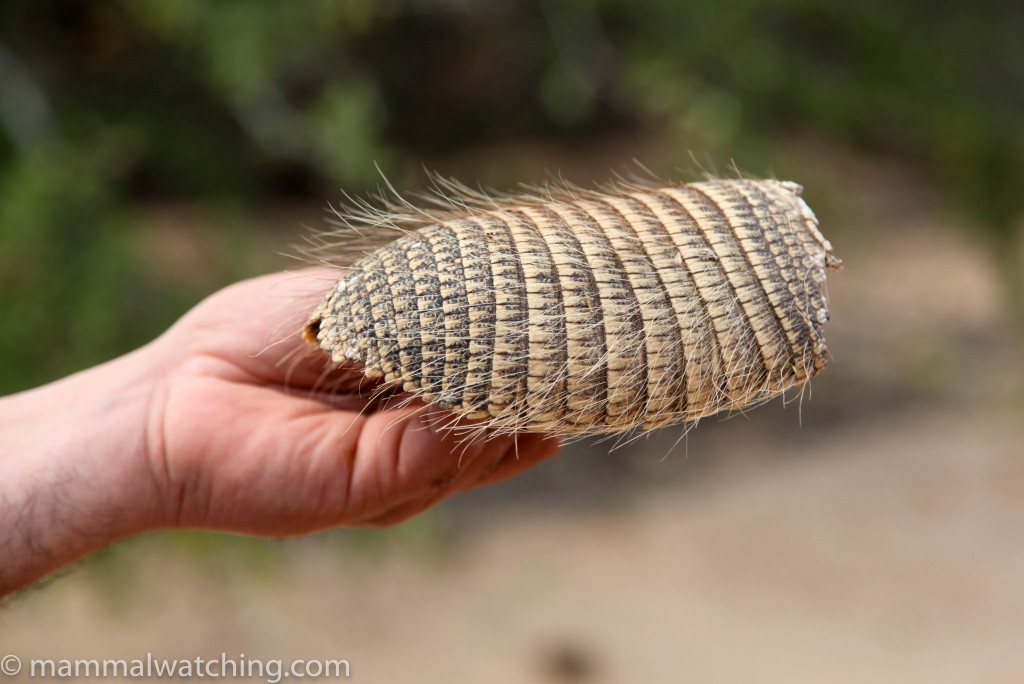
Lesser Hairy Armadillo shell
We saw several Three-banded Armadillos on the road and near the accommodation, but despite a lot of evidence of hairy armadillos (including the shell of a lesser hairy one) we didn’t positively identify a live one. I may have seen on while walking the trap line near the accommodation one evening but it was too fleeting to be sure.
Bats
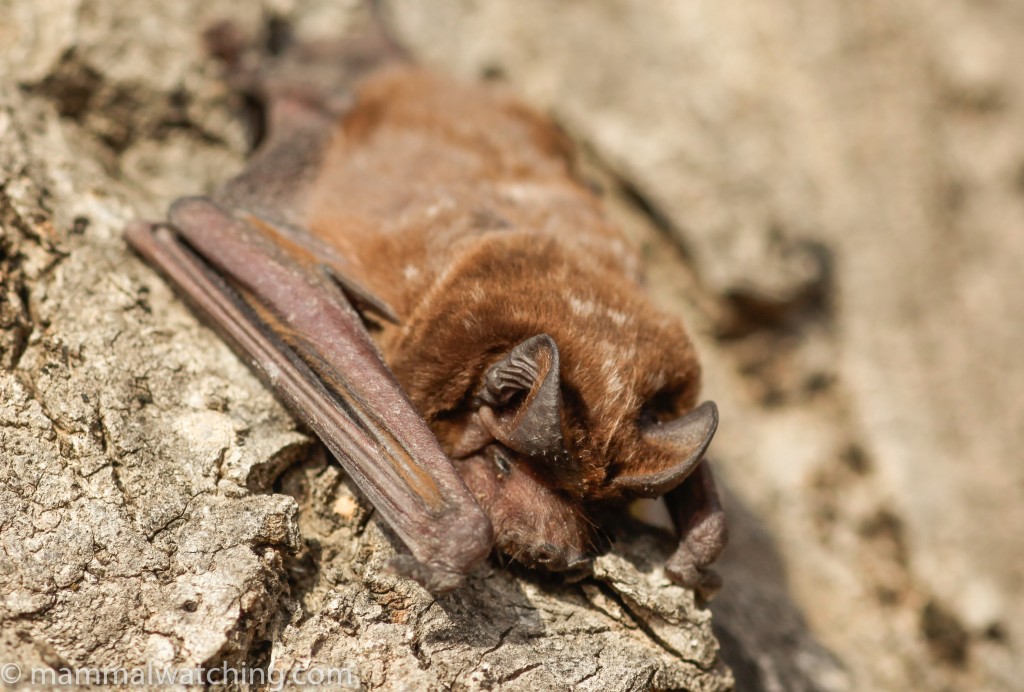
Dwarf Bonneted Bat, Eumops bonariensis
The mist netting and small mammal trapping in Enciso were disappointing, though the low temperatures could not have helped. We caught only two bats: one Eumops species that I am happy to put down as the rather unusual Dwarf Bonneted Bat (Eumops bonariensis) given it had all the characteristics, though if we had wanted to be completely sure it would have been better to have taken the skull, along with one robust Broad-eared Bat (Nyctinomops laticaudatus).
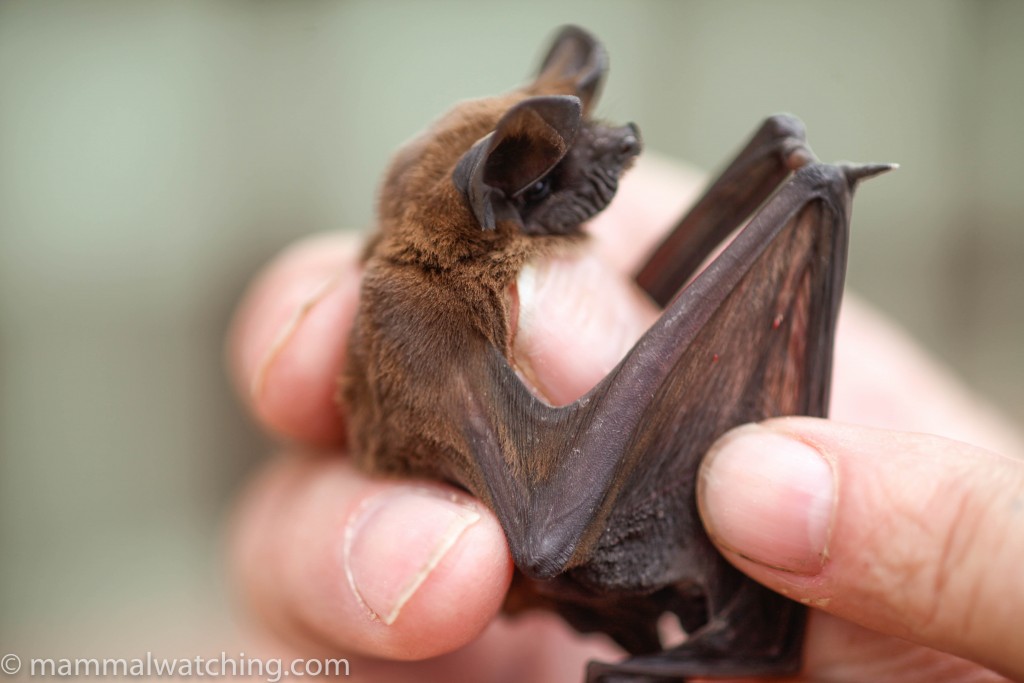
Broad-eared Bat, Nyctinomops laticaudatus
Hugo saw a bat fall out of the air in front of the truck while we were spotlighting. It was still alive. I have no idea why it had crashed. It was another Dwarf Dog-faced Bat (Molossops temminckii).
Small Mammal Trapping
Within a couple of hours of setting the Sherman traps we caught a little Small Fat-tailed Opossum (Thylamys pusillus): great little thing. But after that the traps caught only a few more Chaco Leaf-eared Mice (Graomys chacoensis). Hugo spotted a Lowland Yellow-toothed Cavy which gave fleeting glimpses as it dashed from one clump of vegetation to another.
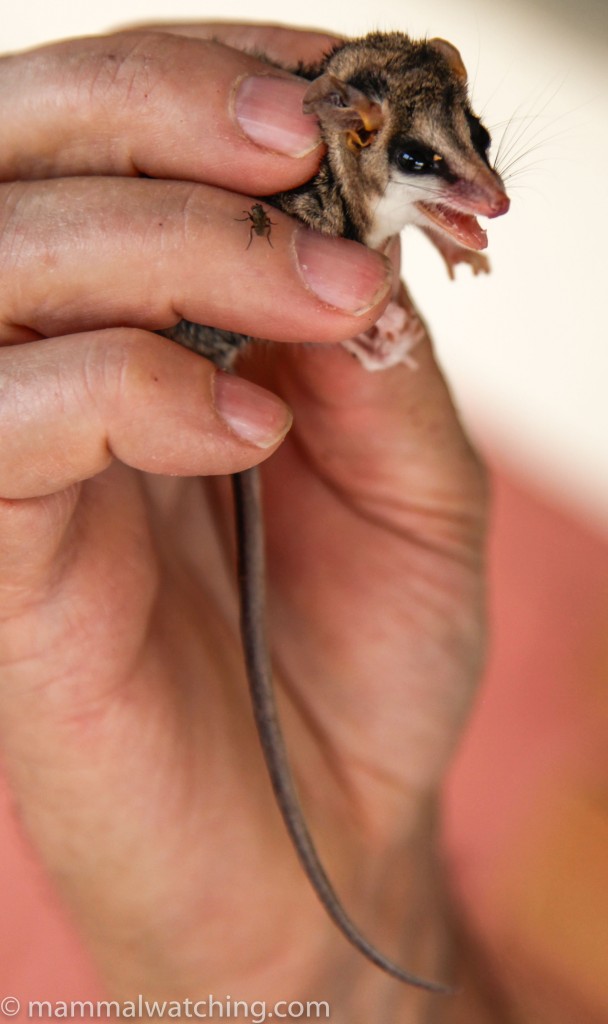
Small Fat-tailed Opossum, Thylamys pusillus
Other Stuff
We saw a few Grey Brocket Deer along the road, and had a distant and very brief look at a dark cat that jumped off the road. I wouldn’t be surprised if it had been a Jaguarundi but we will never know for sure. We had good views of a white cat along the road both at dawn and after dark 12 hours later. It was more than 5km from the nearest cattle station and I would love to turn it into a white morph Geoffroy’s Cat, but it was – I am pretty sure – just a Feral Cat.
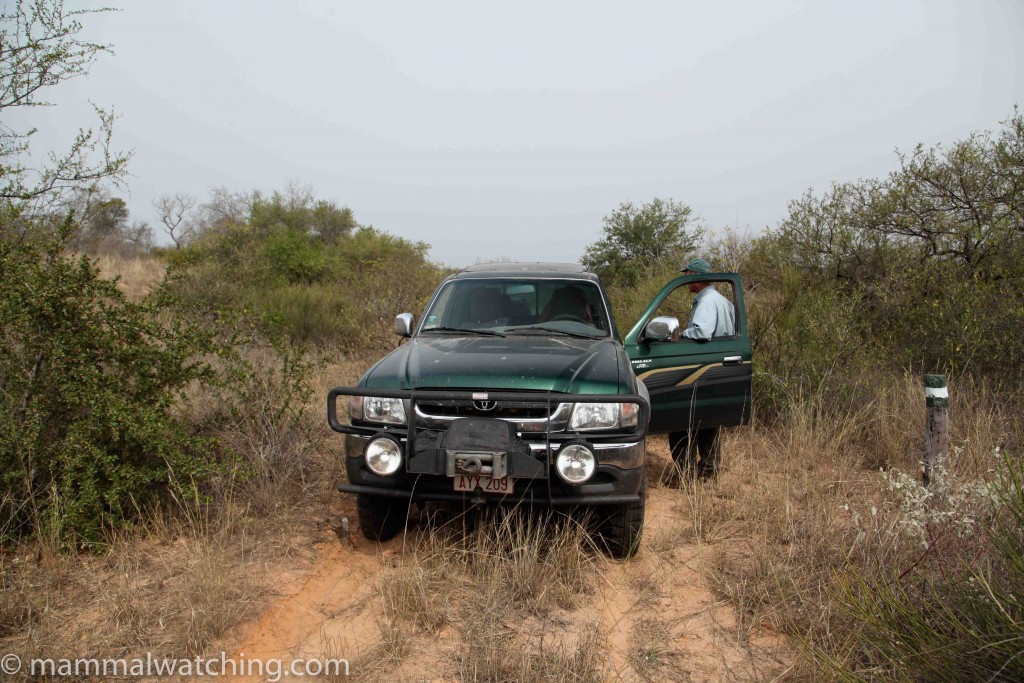
Medanos National Park
One day we took the very sandy road up to Medanos del Chaco national park. The Chaco gets progressively sandier as you head north and there were heaps of Tuco Tuco diggings along the road. We stopped at the Pykasu community to ask whether anyone could catch us a Tuco Tuco. After the Guarani Indians had stopped laughing – why would anyone be interested in Tuco tucos – they advised that they weren’t simple to catch. A few Guanacos live in Medanos NP but they are very hard to see. Hugo has also heard rumours that second, larger species of Agouti (alongside the normal Azara’s Agouti) lives in the park. Possibly Dasyprocta punctata. But we didn’t see one and the Indians didn’t have any skulls or skins to show us.
The Lower Chaco
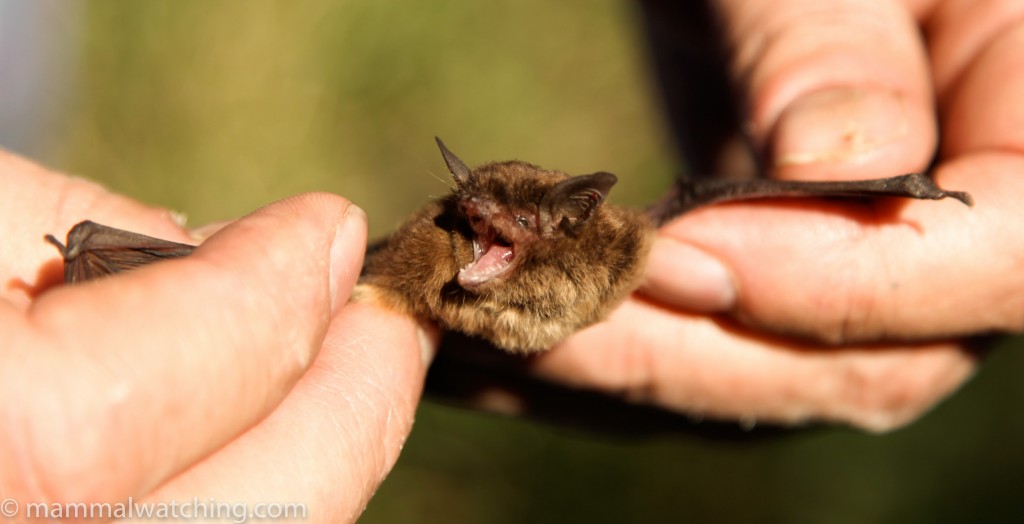
Diminutive Serotine, Eptesicus diminutus
We stopped for a night at the insalubrious Buffalo Bill hotel. It was certainly a cowboy operation. Hugo had to lend them our camping stove to cook us dinner because they had run out of gas … something they didn’t mention until 9 p.m. when we arrived to eat. But the surroundings were nice and there was evidence of Tapir, Crab-eating Raccoon and lots of armadillos (including perhaps Six-banded).
It was a very cold night (there was frost in the morning) and we caught no bats. The small mammal trapping was more successful and we caught more animals than we had on any other night, getting both of the two Callomys species (callosus and laucha) as well as the only Chacoan Pygmy Rice Rat (Oligoryzomys chacoensis) of the trip which unfortunately froze to death in the trap.
We stopped briefly at Los Pioneros nearby to visit their unpleasant zoo. It was interesting to see all three peccary species side by side. The Chacoan flavour really are very different.
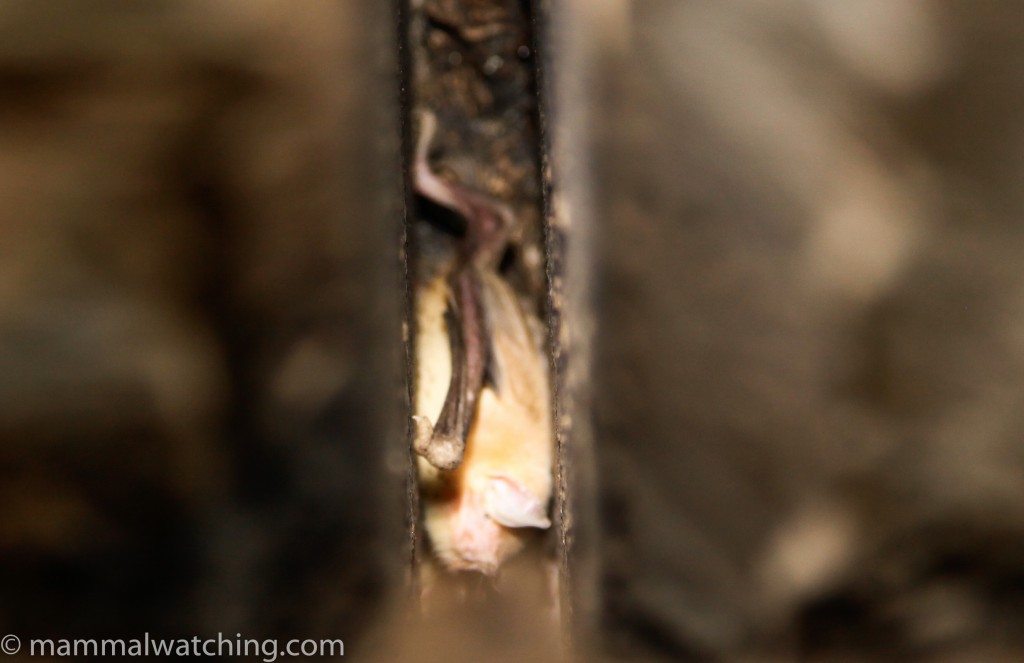
Lesser Fishing Bat, Noctilio albiventris
About half way between the airport and Loma Plata (maybe 20 minutes south of the Buffalo Bill) we stopped at a bat roost under a bridge. A few Lesser Fishing Bats were tucked away among hundreds of myotis bats. At the time we thought they were probably LaVal’s (Black) Myotis (Myotis lavsli), but in 2021 I was told they are Diminutive Serotines.

Stuff I missed
My biggest disappointment was missing two species of hairy armadillos on the trip. I had imagined we’d see both Lesser and Greater Hairy Armadillos, and judging by the number of diggings and burrows they are abundant in many areas, particularly around Enciso. But the best I could manage was just one possible hairy armadillo. I suspect these animals are easier to see when it’s a little warmer, though Three-banded Armadillos were very common, and we saw perhaps 20 during the trip. Six-banded Armadillos are less common but also possible, as – in theory – are Naked-tailed and the wonderful Fairy Armadillos though these latter two species are largely fossorial and rarely seen.
We weren’t particularly lucky with cats either. I had hoped too that we would have seen Geoffroy’s Cat and a Jaguarundi but that was not to be either (though I may well have seen a Jaguarundi on the road at Enciso). With a few more days I guess we would have bumped into both species. I didn’t spend time looking for Jaguars but they are quite common around Defensores in particular and we saw several sets of fresh tracks. I think you’d have a very good chance of seeing them if you set out to look for them.
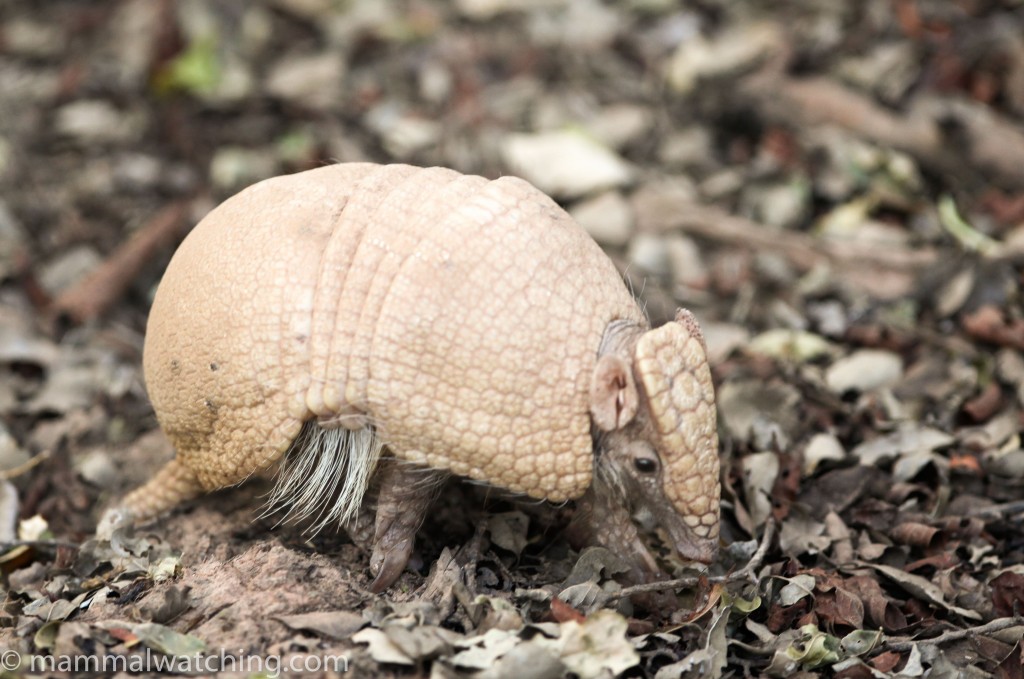
Southern Three-banded Armadillo, Tolypeutes matacus
Interestingly, Romain Bocquier (whose 2012 report is here) told me “In the Chaco, we tried to meet wildlife during the early morning, late evening and night. But during 5 days nothing !! ( only mara and foxes ). Finally a hunter ( of peccaries ) said that he saw, almost every day, pumas or other cats when he walked in the middle of the day during winter. The last day we walked the road from cerro leon to madreiron in the middle of the day and we saw -in four/five hours – the jaguarundis and the Geoffroy’s cat. ” I wish I had known!
Other nice species occasionally seen in the Chaco include Lesser Grisons, and Tuco Tucos which sometimes come above ground.
So fun week, with 24 species and 15 of them lifers. It was the first full-on trapping field trip I had taken since I left Australia and I had forgotten how much I enjoy trying to catch the smaller things as well as see the larger stuff. Paraguay is a great county and Hugo and Rob are the people to see it with – excellent at their jobs and great companions. I suspect that it might be better to go when it is a little warmer though the summer heat must be almost unbearable in the day time. Hopefully I can get back and try to see some bloody hairy armadillos one day. There is a lot of space for them to hide ….
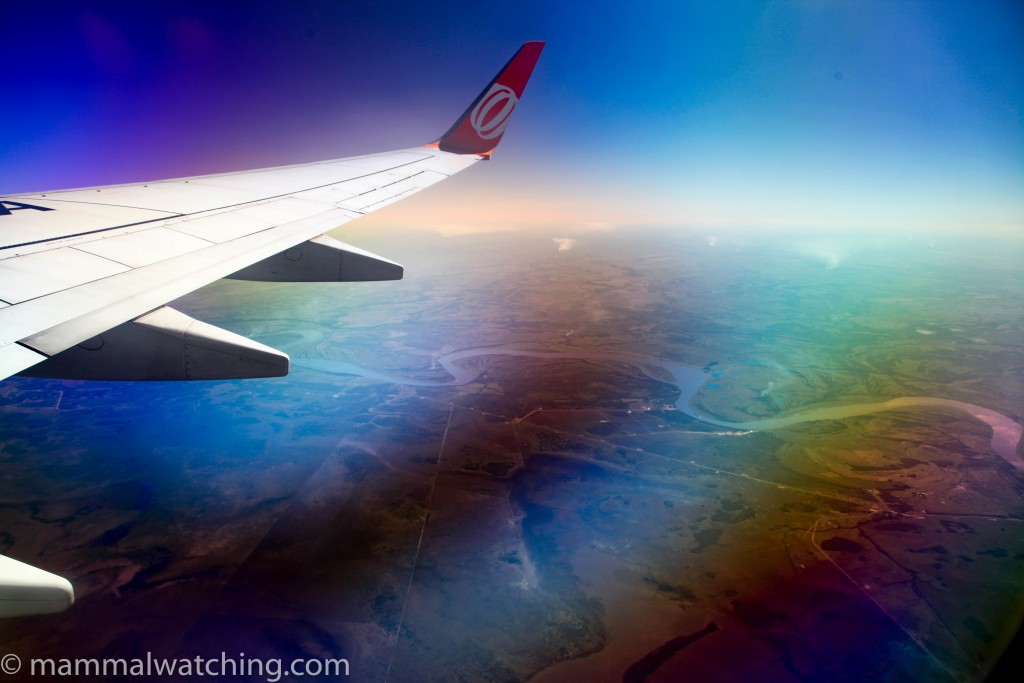
Somewhere over the Chaco
Species Seen
1. F Agile Gracile Mouse-Opossum Gracilinanus agilis
2. F Small Fat-tailed Opossum Thylamys pusillus
3. F Southern Three-banded Armadillo Tolypeutes matacus
4. F Large Vesper Mouse Calomys callosus
5. F Small Vesper Mouse Calomys laucha
6. F Chaco Leaf-eared Mouse Graomys chacoensis
7. F Lowland Yellow-toothed Cavy Galea leucoblephara
8. F Chacoan Mara Dolichotis salinicola
9. F Plains Viscacha Lagostomus maximus
10. Puma Felis concolor
11. Pampas Fox (Argentine Gray Fox) Pseudalopex gymnocercus
12. Crab-eating Fox Cerdocyon thous
13. Lesser Fishing Bat Noctilio albiventris
14. F Dwarf Dog-faced Bat Molossops temminckii
15. Dwarf Dog-faced Bat Molossops temminckii
16. F Broad-eared Bat Nyctinomops laticaudatus
17. F Dwarf Bonneted Bat Eumops bonariensis
18. F Argentine Brown Bat Eptesicus furinalis
19. F Diminutive Serotines Eptesicus diminutus
20. Black-tailed Marmoset Callithrix melanura
21. Azara’s Night Monkey Aotus azarai
22. F Pallid Titi Callicebus pallescens
23. F Chacoan Peccary Catagonus wagneri
24. Gray Brocket Mazama gouazoupira
25. Brazilian Tapir Tapirus terrestris
26. Feral Cat Felis catus
plus a possible Jaguarundi, the sound of an Azara’s Agouti, the remains of a Lesser Hairy Armadillo and a dead Chacoan Pygmy Rice Rat.
Community Reports
Paraguayan Chaco, 2024: Karina and Andrey, 18 days & 31 species including Puma, Giant Anteater, Chaco Mara and 10 Tapirs.
Reserva Canada el Carmen, Chaco, 2024: Karina and Andrey’s detailed summary of the mammalwatching opportunities in the park, featuring 20 species including Chaco Naked-tailed Armadillo, Giant Anteater and Chaco Peccary.
Paraguay, 2023: Stuart Chapman, 2 weeks & 28 species including Geoffroy’s Cat, 3 armadillo species and two tuco-tucos too.
Dry Chaco – Cat Roundup, 2022: Chris D’s report of multiple cat trips and with Geoffroy’s Cat and Jaguarundi in Paraguay.
Paraguay, 2022: Tomer Ben-Yehuda, 12 days & 32 species including Geoffroy’s Cat, Lesser Grison, Giant Anteater and 4 Armadillo species.
Paraguay, 2022: Rob & Romy Jansen, 23 days & 31 species including Screaming Hairy Armadillo, Chaco Peccary, Geoffroy’s Cat and Jaguar
Paraguay, 2021: Cheryl Antonuccci, 10 days and 31 species including Conover’s Tuco-tuco, Greater & Lesser Hairy Armadillos, Lesser Grison, Jaguarundi and Geoffroy’s Cat.
Paraguayan Chaco and Emas National Park, Brazil, 2019: Dominique Brugiere, 2 weeks & species including Ocelot, Jaguar, Chacoan Peccary in Paraguay and a Maned Wolf in Brazil.
Estancia Montana, 2019: Andreas Jonsson, 4 days & 13 species including Geoffroy’s Cat, Giant Anteater, and Screaming and Large Hairy Armadillos.
Defensores del Chaco, 2019: Sophie and Manuel Baumgartner, 9 days & 19 species including Screaming Hairy Armadillo, Paraguay Punaré, Geoffroy’s Cat and Ocelot.
Bolivia and Paraguay, 2018: Domique Brugiere, 1 month with species including Jaguarundi, Jaguar, Puma, Ocelotand Tayra.
Paraguay, 2016: Hervé & Noëlle Jacob, 1 month and the mammals included Greater Hairy Armadillo, Jaguarundi, Margay, Geoffroy’s Cat and Chaco Peccaries. Lots of details for independent travel.
Paraguay, 2015: Robert Foster, 2 weeks & 19 live species including Greater Hairy Armadillo, Puma, Geoffroy’s Cat and Chaco Peccary.
Paraguay, 2014: Jon Lehmberg, 1 week & 21 species including 5 Armadillo species, Jaguarundi and a Tapir.
Paraguay, 2014: Hugh Buck, 3 weeks of birding but nevertheless 32 mammals including Lesser Grison, Chaco Peccary, Geoffroy’s Cat and a Puma.
Brazil, Paraguay and Peru, 2012: Romain Bocquier, mega-trip of 7 weeks & 43 species incuding Sechuran Fox & Taruca (Peru), Jaguar & Tayra (Brazil) and Jaguarundi & Geoffroy’s Cat (Paraguay).
Paraguay, 2009: Sjef Ollers, 3 weeks & 24 live species plus a few dead ones. Excellent report including Jaguar, Puma, Geoffroy’s Cat and Chacoan Peccary.
Also See
Check out Karina and Andrey from Wild Chaco Expeditions on the mammalwatching podcast, December 2022
Free advice on visiting Paraguay from the Travelling Zoologists Karina and Andrey, June 2023
Resources
FAUNA Paraguay – “Dedicated to the study of the Paraguayan fauna, this site counts on a huge image gallery of photos and videos, as well as supporting local conservation projects. Expert-led eco-tours to the Chaco (a paradise for mammals) and Atlantic forest also on offer.” They now offer a special mammal trip, which includes bat and small mammal trapping (see my report above)


Leave a Reply
You must be logged in to post a comment.